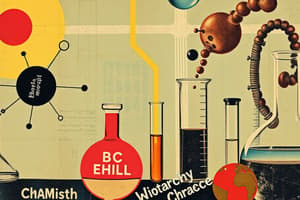Podcast
Questions and Answers
What is a decomposition reaction?
What is a decomposition reaction?
- A reaction where two substances combine to form a new compound
- A reaction in which a single compound breaks down to form two or more simpler substances (correct)
- A reaction where elements exchange places in two compounds
- A reaction that requires high temperatures
What occurs in a double-displacement reaction?
What occurs in a double-displacement reaction?
The ions of two compounds exchange places to form two new compounds.
What is a net ionic equation?
What is a net ionic equation?
An equation showing only the particles directly involved in a chemical change.
What characterizes a single-displacement reaction?
What characterizes a single-displacement reaction?
What does the activity series list?
What does the activity series list?
What is a synthesis reaction?
What is a synthesis reaction?
What happens in a combustion reaction?
What happens in a combustion reaction?
What are the combustion products of hydrocarbons?
What are the combustion products of hydrocarbons?
What is the Law of Conservation of Mass?
What is the Law of Conservation of Mass?
Insoluble means capable of being dissolved.
Insoluble means capable of being dissolved.
An aqueous solution is one in which water is the solvent.
An aqueous solution is one in which water is the solvent.
What is a precipitate?
What is a precipitate?
The type of reaction where an element replaces another in a compound is called a ______.
The type of reaction where an element replaces another in a compound is called a ______.
What do chemical equation symbols represent?
What do chemical equation symbols represent?
Which types of chemical reactions likely have an element as one of their products?
Which types of chemical reactions likely have an element as one of their products?
Flashcards are hidden until you start studying
Study Notes
Types of Chemical Reactions
- Decomposition Reaction: A single compound breaks down into two or more simpler substances.
- Double-Displacement Reaction: Ions from two compounds switch places in an aqueous solution to create two new compounds; requires adherence to solubility rules. Involves the replacement of cations and anions.
- Single-Displacement Reaction: One element replaces another element in a compound.
Reaction Mechanisms
- Net Ionic Equation: Represents only the particles directly involved in a chemical change, excluding spectator ions.
- Insoluble and Soluble: Insoluble substances cannot dissolve in a solvent; soluble substances can dissolve (designated as "aq" in equations).
- Aqueous Solution: A solution where water serves as the solvent.
Specific Reaction Types
- Synthesis Reaction: Involves the combination of two or more substances to create a new compound.
- Combustion Reaction: An element or compound reacts with oxygen, generating energy as heat and light; products typically include carbon dioxide (CO2) and water (H2O).
Chemical Principles
- Activity Series: Lists elements in order of decreasing activity; crucial for predicting the viability of single-displacement reactions, especially among halogens: F, Cl, Br, I.
- Law of Conservation of Mass: Mass remains constant during chemical and physical changes; though the number of compounds or molecules may change, the total mass and atomic count do not.
Chemical Products
- Combustion Products of Hydrocarbons: The typical products formed are CO2 and H2O.
- Precipitate: A solid that emerges from a solution during a chemical reaction, noted as (s) in equations.
Other Considerations
- Chemical Equation Symbols: Symbols and formulas used to succinctly represent chemical reactions.
- Reactions Likely Involving Elements: Decomposition and single-replacement reactions typically yield an element as one of the products.
Studying That Suits You
Use AI to generate personalized quizzes and flashcards to suit your learning preferences.




